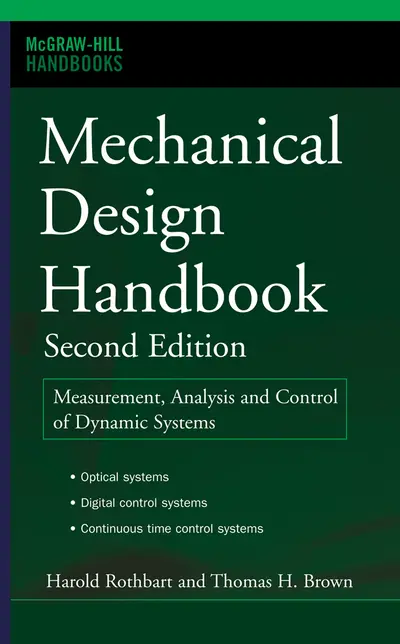My Account Details

ISBN10: 0071466363 | ISBN13: 9780071466363

Part 1: Mechanical Design FundamentalsChapter 1: Classical MechanicsChapter 2: Mechanics of MaterialsChapter 3: Kinematics of MechanismsChapter 4: Mechanical VibrationsChapter 5: Static and Fatigue DesignChapter 6: Properties of Engineering MaterialsChapter 7: Friction, Lubrication, and WearPart 2: Mechanical Systems AnalysisChapter 8: System DynamicsChapter 9: Continuous Time Control SystemsChapter 10: Digital Control SystemsChapter 11: Optical SystemsChapter 12: Machine SystemsChapter 13: System ReliabilityPart 3: Mechanical Subsystem ComponentsChapter 14: Cam MechanismsChapter 15: Rolling-Element BearingsChapter 16: Power ScrewsChapter 17: Friction ClutchesChapter 18: Friction BrakesChapter 19: BeltsChapter 20: ChainsChapter 21: GearingChapter 22: SpringsAppendix A: Analytical Methods for EngineersAppendix B: Numerical Methods for EngineersIndex
Chapter 2: Mechanics of MaterialsChapter 3: Kinematics of MechanismsChapter 4: Mechanical VibrationsChapter 5: Static and Fatigue DesignChapter 6: Properties of Engineering MaterialsChapter 7: Friction, Lubrication, and WearPart 2: Mechanical Systems AnalysisChapter 8: System DynamicsChapter 9: Continuous Time Control SystemsChapter 10: Digital Control SystemsChapter 11: Optical SystemsChapter 12: Machine SystemsChapter 13: System ReliabilityPart 3: Mechanical Subsystem ComponentsChapter 14: Cam MechanismsChapter 15: Rolling-Element BearingsChapter 16: Power ScrewsChapter 17: Friction ClutchesChapter 18: Friction BrakesChapter 19: BeltsChapter 20: ChainsChapter 21: GearingChapter 22: SpringsAppendix A: Analytical Methods for EngineersAppendix B: Numerical Methods for EngineersIndex
Chapter 4: Mechanical VibrationsChapter 5: Static and Fatigue DesignChapter 6: Properties of Engineering MaterialsChapter 7: Friction, Lubrication, and WearPart 2: Mechanical Systems AnalysisChapter 8: System DynamicsChapter 9: Continuous Time Control SystemsChapter 10: Digital Control SystemsChapter 11: Optical SystemsChapter 12: Machine SystemsChapter 13: System ReliabilityPart 3: Mechanical Subsystem ComponentsChapter 14: Cam MechanismsChapter 15: Rolling-Element BearingsChapter 16: Power ScrewsChapter 17: Friction ClutchesChapter 18: Friction BrakesChapter 19: BeltsChapter 20: ChainsChapter 21: GearingChapter 22: SpringsAppendix A: Analytical Methods for EngineersAppendix B: Numerical Methods for EngineersIndex
Chapter 6: Properties of Engineering MaterialsChapter 7: Friction, Lubrication, and WearPart 2: Mechanical Systems AnalysisChapter 8: System DynamicsChapter 9: Continuous Time Control SystemsChapter 10: Digital Control SystemsChapter 11: Optical SystemsChapter 12: Machine SystemsChapter 13: System ReliabilityPart 3: Mechanical Subsystem ComponentsChapter 14: Cam MechanismsChapter 15: Rolling-Element BearingsChapter 16: Power ScrewsChapter 17: Friction ClutchesChapter 18: Friction BrakesChapter 19: BeltsChapter 20: ChainsChapter 21: GearingChapter 22: SpringsAppendix A: Analytical Methods for EngineersAppendix B: Numerical Methods for EngineersIndex
Part 2: Mechanical Systems AnalysisChapter 8: System DynamicsChapter 9: Continuous Time Control SystemsChapter 10: Digital Control SystemsChapter 11: Optical SystemsChapter 12: Machine SystemsChapter 13: System ReliabilityPart 3: Mechanical Subsystem ComponentsChapter 14: Cam MechanismsChapter 15: Rolling-Element BearingsChapter 16: Power ScrewsChapter 17: Friction ClutchesChapter 18: Friction BrakesChapter 19: BeltsChapter 20: ChainsChapter 21: GearingChapter 22: SpringsAppendix A: Analytical Methods for EngineersAppendix B: Numerical Methods for EngineersIndex
Chapter 9: Continuous Time Control SystemsChapter 10: Digital Control SystemsChapter 11: Optical SystemsChapter 12: Machine SystemsChapter 13: System ReliabilityPart 3: Mechanical Subsystem ComponentsChapter 14: Cam MechanismsChapter 15: Rolling-Element BearingsChapter 16: Power ScrewsChapter 17: Friction ClutchesChapter 18: Friction BrakesChapter 19: BeltsChapter 20: ChainsChapter 21: GearingChapter 22: SpringsAppendix A: Analytical Methods for EngineersAppendix B: Numerical Methods for EngineersIndex
Chapter 11: Optical SystemsChapter 12: Machine SystemsChapter 13: System ReliabilityPart 3: Mechanical Subsystem ComponentsChapter 14: Cam MechanismsChapter 15: Rolling-Element BearingsChapter 16: Power ScrewsChapter 17: Friction ClutchesChapter 18: Friction BrakesChapter 19: BeltsChapter 20: ChainsChapter 21: GearingChapter 22: SpringsAppendix A: Analytical Methods for EngineersAppendix B: Numerical Methods for EngineersIndex
Chapter 13: System ReliabilityPart 3: Mechanical Subsystem ComponentsChapter 14: Cam MechanismsChapter 15: Rolling-Element BearingsChapter 16: Power ScrewsChapter 17: Friction ClutchesChapter 18: Friction BrakesChapter 19: BeltsChapter 20: ChainsChapter 21: GearingChapter 22: SpringsAppendix A: Analytical Methods for EngineersAppendix B: Numerical Methods for EngineersIndex
Chapter 14: Cam MechanismsChapter 15: Rolling-Element BearingsChapter 16: Power ScrewsChapter 17: Friction ClutchesChapter 18: Friction BrakesChapter 19: BeltsChapter 20: ChainsChapter 21: GearingChapter 22: SpringsAppendix A: Analytical Methods for EngineersAppendix B: Numerical Methods for EngineersIndex
Chapter 16: Power ScrewsChapter 17: Friction ClutchesChapter 18: Friction BrakesChapter 19: BeltsChapter 20: ChainsChapter 21: GearingChapter 22: SpringsAppendix A: Analytical Methods for EngineersAppendix B: Numerical Methods for EngineersIndex
Chapter 18: Friction BrakesChapter 19: BeltsChapter 20: ChainsChapter 21: GearingChapter 22: SpringsAppendix A: Analytical Methods for EngineersAppendix B: Numerical Methods for EngineersIndex
Chapter 20: ChainsChapter 21: GearingChapter 22: SpringsAppendix A: Analytical Methods for EngineersAppendix B: Numerical Methods for EngineersIndex
Chapter 22: SpringsAppendix A: Analytical Methods for EngineersAppendix B: Numerical Methods for EngineersIndex
Appendix B: Numerical Methods for EngineersIndex
Need support? We're here to help - Get real-world support and resources every step of the way.